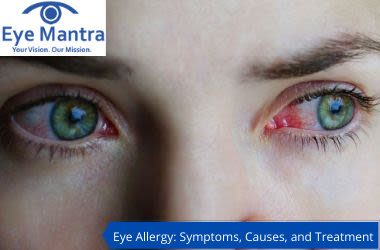
Contents
An eye allergy or allergic conjunctivitis is a severe immune response occurring when the eye comes into contact with an irritating substance. If you are witnessing itchiness in your eye and your eyes turn red, teary, or you feel a burning sensation, then you might have eye allergies (allergic conjunctivitis), a condition that affects many people. They are quite common and occurs when eyes react to something that irritates them. A substance called histamine is produced by the eyes to fight off the allergen. Due to this, the eyelids and conjunctiva become red, swollen, and itchy. In this condition, tearing and burning of the eyes is common.
Eye allergies are incapable of spreading from one person to another. People having eye allergies commonly have nasal allergies too, with an itchy, stuffy nose and sneezing. It is a temporary condition that is related to seasonal allergies. You are capable of getting an eye allergy from pet dander, smoke, pollen, dust, perfumes, or even food. If you fail to avoid the cause, these allergies can be more serious. You may further experience burning and itching and even extreme sensitivity to light. Allergic or vernal keratoconjunctivitis might result in scarring of the cornea and other vision problems.
Due to excessive fluid in the eye, eye discharge occurs. It can be clear as well as watery and thick as well as opaque. Causes of eye discharge can be many ranging from infections to allergic reactions. Allergic reactions can make your eyes itchy and watery. Pinkeye or conjunctivitis is caused by both allergies and infections. Eye discharge related to infections is generally accompanied by some other symptoms that include:
There are some other symptoms as well in few cases such as a stuffy, runny nose, and sneezing. Some people may also experience a headache, an itchy or sore throat, or coughing.
An allergy can be explained when a human body’s immune system starts reacting to a normally harmless allergen. The moment an allergen comes in contact with your eye, particular cells within your eye (called mast cells) produce histamine and other substances to fight off the allergen. This reaction leads your eyes to become red, itchy, and watery.
Allergens present in the air whether indoor or outdoor lead to many eye allergies. These allergens include:
In a few cases, people can be allergic to preservative chemicals in lubricating or prescribed eye drops. So, if possible, the affected person should use preservative-free drops instead.
Also, the eyes can react to other allergens that don’t even come in direct contact with the eye. For example, specific foods or insect bites or stings.
There are cases where people tend to inherit eye allergies from their parents. Both of your parents having allergies is more a threat to you for inheriting them than one of them having it.
Basic Anatomy Of The Outer Eye
Eye allergies involve the conjunctiva. Conjunctiva is the tissue lining (mucus membrane) covering the white surface of the eyeball and the inner folds of the eyelids. The conjunctiva can be understood as a barrier structure that is very much exposed to the environment and the many different allergens that become airborne. It is rich in blood vessels and carries more mast cells than the lungs.
The lacrimal (tear) glands are located in the upper portions and the outer portions of the eye. They are responsible for releasing the watery part of tears, which maintains the moisture of the eye and washes irritants away. The tears carry crucial elements of immune defense like immunoglobulins (antibodies), lymphocytes (specialized white blood cells), and enzymes.
The cornea is the transparent sheath in front of the lens of the eye. The cornea contains no blood vessels and little immune activity.
Options for treatment may include topical antihistamine drops like olopatadine (Patanol), decongestants, and the latest mast-cell stabilizer medications. Topical steroids must be used only when prescribed by a doctor for intense reactions and on a short-term basis due to the potential for side effects. Generally, oral antihistamines like loratadine (Claritin) or cetirizine (Zyrtec) are considered the least effective option, however, they are used often for treating allergic rhinitis with allergic conjunctivitis
[video_lightbox_youtube video_id=”WmC7Z_uqKyg” width=”1200″ height=”800″ auto_thumb=”1″]
The best way to treat your eyes is to visit your eye care professional and get your eyes checked regularly. We will be able to assess the best method of treatment for your eye ailment.
Visit our website Eyemantra.
To book an appointment call +91-9711115191 Or mail us at eyemantra1@gmail.com.
Our other services include Retina Surgery, Specs Removal, Cataract Surgery, and many more.